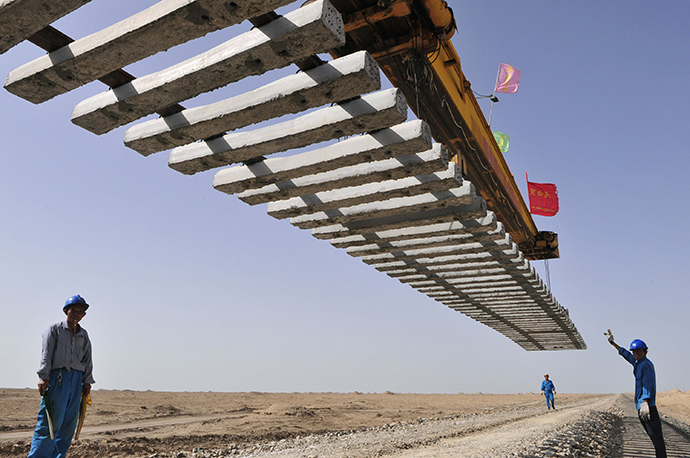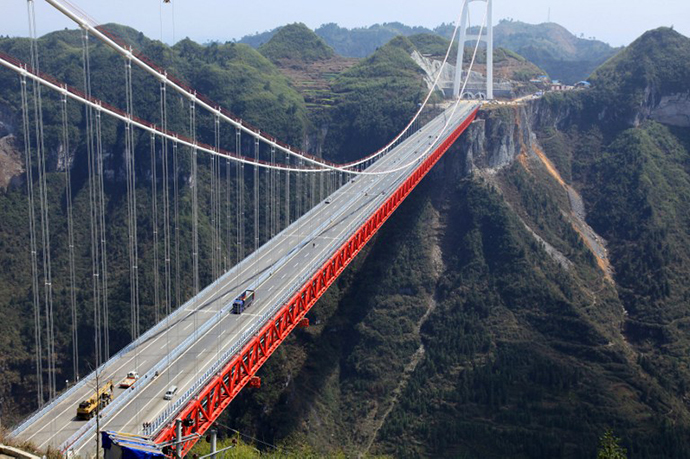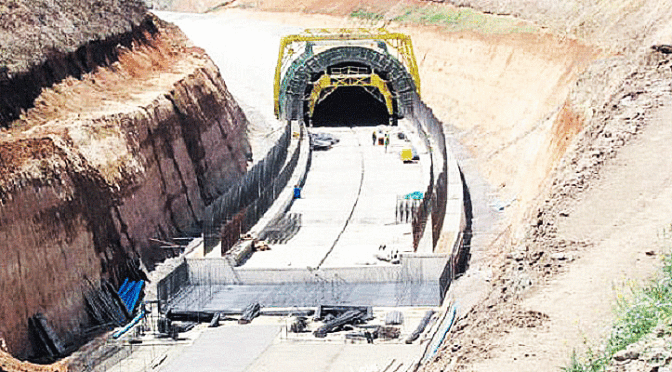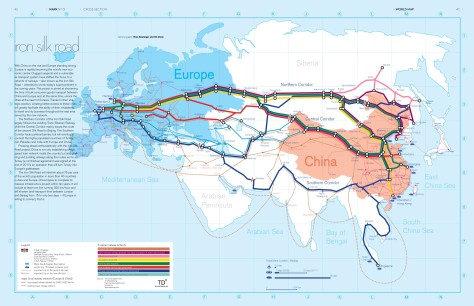THE UNSTOPPABLE BREAKNECK-SPEED EXPANSION OF THE GREAT EURASIAN CORRIDOR
Covert Geopolitics
The BRICS Alliance is forcing the world away from the geopolitics of endless wars and regime change into a world of scientific progress and development.
This has been the renewed invitation of the Russian President Vladimir Putin in his welcome address to the 20th St. Petersburg International Economic Forum.
The forum is also in synergy with other Eurasian economic integrations that are working alongside China’s “One Belt, One Road” global economic program aimed at reviving the ancient Silk Road with a modern twist including high speed railway systems, and state-of-the-art air and sea ports along the path traversed by the planned Silk and Maritime Road spanning the entire Eurasian continent, Latin America and South Africa.
These are ongoing projects that are being talked about in the mainstream media which is only focusing on the supposed China economic slowdown.
Well, there’s no slowdown in China. The country is focusing more on domestic consumption simply because the West could not afford to pay all their products anymore especially now that they are requiring payment s only with asset-backed currencies. It has instead focused more on spreading its wings across Eurasia.
A 70km hyperloop transport system will also be installed in the Russian Far East alongside other railway projects in Central Eurasian regions, with Chinese investments.
Looping The New Silk Road

“Summa Chairman Magomedov, a billionaire industrialist with infrastructure holdings across Russia, sees an equal and potentially far bigger opportunity to use freight Hyperloop networks. Summa’s portfolio includes ports, telecom, energy and mining. Its Caspian VC investment group has a stake in Hyperloop One. “The implementation of Hyperloop technology provides tremendous benefits to the Russian Federation in terms of the geopolitical development of the intracontinental transit potential and building of an economically attractive alternative to the existing global logistics flows,” says Magomedov. “In the long term Hyperloop could catalyze the development of regional economic integration, including the Eurasian Economic Union and the Chinese initiative “One Belt – One Road” The initiative, often called the New Silk Road, is China’s grand vision of connecting through Central Asia to Europe through dedicated rails, highways and shipping lanes, providing all the infrastructure in between.
Russian transportation minister Maksim Sokolov, also at the St. Petersburg Economic Forum, found what he says is a promising first location for Russia’s first Hyperloop: a 70-kilometer run between China’s mineral and manufacturing heavy Jilin province and Zarubino, a port on Russia’s Far Eastern coast. Zarubino still has a bucolic feel to it. Fifteen years from now, with decent global trade growth and a warming climate, Zarubino could grow into a bustling Hyperloop terminal—free of truck pollution–where Jilin carmakers ship containers of finished automobiles at cruising speeds of 700 mph to port-side cranes to be lifted onto ships for export.
Sokolov intends to co-fund the project with the Chinese. “We have a fund to support the Silk Road projects. I believe that this project may count on 100% co-financing from this fund,” he said. Discussions with the federal government are underway for a second feasibility study, with an agreement expected later this year. Russian news site RT.com quoted Sokolov saying that a 70-kilometer cargo Hyperloop in Russia’s Far East would cost $450 million to $607 million, less than half the price per mile of the 770-kilometer high-speed rail link planned between Moscow and Khazan that’s expected to cost $15 billion.”
http://www.strategic-culture.org/news/2016/06/23/its-all-about-eurasia-integration.html
Aside from Russia, other countries like Pakistan and Turkey are also on board…
As reported by the Chinese news agency, Xinhua, last February:“China and Pakistan agreed … to facilitate the construction of a China-Pakistan economic corridor, with a focus on cooperation in energy, industrial parks and transportation infrastructure.”
Pakistani President Mamnoon Hussain even traveled to the Chinese capital for the occasion. This economic corridor will take the shape of an actual rail link, including the construction of China’s longest tunnels in the process. The first tunnel completed runs 22.24 km through the mountainous Xinjiang Uygur Autonomous Region and will reduce the distance between Turpan with Korla in southern Xinjiang by 122 km (from originally 334 km). Additionally, China is also planning to build a $30-billion undersea tunnel as part of the China-Pak economic corridor.

‘This ambitious rail link is part of China’s wider ambitions in neighboring Central Asia. As the ‘Middle Kingdom’ always plans for the long-term, China already secured the construction of a Turkmen-Kazakh-China pipeline in 2007 – 7,000 kilometers of steel pipe at a staggering cost of $26 billion. The rail and pipeline link, connecting China to Central Asia and Pakistan on its western reaches, has been part of the rivalry between world powers to assert primacy in, what the Pakistani author Ahmed Rashid has aptly termed, the “New Great Game.”
This new rivalry centers primarily around access to the massive underground reserves in Turkmenistan. But even beyond this energy scheme, China has now also set its sights on reviving the Silk Road, capitalizing on rail links between Pakistan and its “strategic partner”, Turkey.”‘

Whereas Xinhua reported that “bilateral economic and trade cooperation, infrastructure and technical consulting cooperation, cultural exchange, technical cooperation in information and communications, marine cooperation and railway construction” were also agreed upon by China and Turkey, adding that both countries “aim to boost the bilateral trade value to US$50 billion by 2015 from the current US$17 billion.”
http://www.rt.com/op-edge/china-crisis-crimea-russia-889/
Dictator Erdogan is playing both sides of the geopolitical spectrum just so he could revive his Ottoman imperialistic ambitions.
Here’s a good summary of how the world is shifting towards the East by virtue of the Western populations’ inaction and virtual consent to the regressive master plan of the Black Nobility and Nazionist factions of the Cabal.
It’s All About Eurasia Integration
By Pepe Escobar

The key takeaway of the 20th St. Petersburg International Economic Forum (SPIEF) – 30 ministers from 21 nations and 880 CEOs attending – predictably was all about the key socioeconomic story of the 21st century: Eurasia integration.
President Putin put it quite mildly, actually, when he said that, «with our partners, we believe the Eurasian Economic Union may be one of the centers of broader integration [with Asia]». The EEU, as we speak, unites Russia, Armenia, Belarus, Kazakhstan and Kyrgyzstan, with Tajikistan as a prospective member.
But then came the kicker: «We are suggesting the creation of a larger Eurasian partnership involving the Eurasian Economic Union and countries with which we have already had a close relationship: China, India, Pakistan, Iran».
That accounts for no less than the intersection of the EEU with the Chinese-driven One Belt, One Road (OBOR); the Shanghai Cooperation Organization (SCO); the Asian Infrastructure Investment Bank (AIIB); the BRICS’s New Development Bank (NDB); and of course all this part of the Big Picture footprint of the Russia-China strategic partnership.
It naturally mergers the desire expressed by Putin years ago of a free trade zone «from Lisbon to Vladivostok» with the Chinese vision of OBOR as total Eurasia integration. The West’s competing project, meanwhile, barely ventures beyond NATO expansion; make fear, not business. So Putin once again was forced to repeat theobvious; NATO «needs a foreign enemy, otherwise what would be the reason for the existence of such an organization».
The facts are on the table concerning the relentless advance of a Beltway-deployed Hybrid War against Russia. Apart, and beyond, an eventual Russian counterpunch, what really matters is business.
Thus Putin’s pledge to support «Russian export-orientated companies, strengthening our positions in the international market».
Kazakh President Nursultan Nazarbayev added, «disintegration and economic isolationism will not solve any internal problems; it will be only a self-deception. The Eurasian Economic Union is interested in an efficient and stable European Union… Similarly, it’s advantageous for a United Europe to cooperate with our union».
Meanwhile, cooperation inside the SCO is also advancing. India and Pakistan are joining as full members, and Iran’s turn is practically certain in 2017. Nazarbayev: «This organization that will unite three billion people is becoming very powerful. Isn’t it profitable to anyone to cooperate with such an organization?»
The OBOR-EEU-SCO interpenetration, on an economic level, portends the development of an astonishingly ample economic bloc that will position itself as a counterpoint to the Obama administration-peddled Trans-Pacific Partnership (TPP). Moscow is not only driving the EEU closer to all SCO members but also is keen to expand it to the 10-member Association of Southeast Asian Nations (ASEAN). Putin framed the initial phase of the partnership as based on investment protection; trade facilitation; joint development of standards for the production of next-generation technology; and better access to services and capital markets.
Business as usual
On the Western front Italy, via Prime Minister Matteo Renzi, made it clear the continued automatic extension of EU sanctions on Russia is counterproductive. Italian and Russian companies clinched $1.7 billion in deals at SPIEF. Royal Dutch/Shell signed a deal with Gazprom to be part of a $10 billion LNG project on the Baltic Sea. Rosneft and BP signed a binding deal for a joint venture, Ermak Neftegaz, exploring oil in Siberia.
All this happened even after Washington applied trademark relentless pressure over a string of European governments trying to block businessmen from attending SPIEF. Compare it to Gazprombank’s First Vice President, Oleg Vaksman, noting that foreign investors badly want to buy Russian stocks and bonds, but not enough are available.
Any CEO with sound judgment across the eurozone knows that Moscow is not exactly desperate for Western investment. They just need to look at the myriad aspects of the Russia-China partnership.
China will be extremely active improving Russian connectivity for years to come. The key example concerns the superfast Hyperlooptechnology – high-speed in tubes with capsules propelled by linear induction motors and air compressors. Hyperloop is projected to be in use along a 70-kilometer strip of Russia’s first super high-speed transport system to its Pacific port of Zarubino, in the Far East. Chinese investors will inevitably come up with the up to $600 million financing. The high-speed rail project between Moscow and Kazan is also advancing.
These projects are of course closely tied with OBOR – the categorical imperative of building myriad land bridges across Eurasia. And that also ties in with internal BRICS cooperation. Three months ago Rosneft sold stakes in two top eastern Siberian oil fields to three Indian companies. India’s Oil and Natural Gas Corporation (ONGC) signed an agreement to buy a 23.9 percent stake in the Vankor oil field in East Siberia (Russia’s second largest by production) from Rosneft for about $2.1 billion. ONGC signed deals worth $5 billion during SPIEF.
Investment funds from the United Arab Emirates are also creeping in, having done business through the Russian Direct Investment Fund, particularly in agriculture. And Middle East investment funds are also about to access the Russian military-industrial complex.
In a two-way street mode, Moscow’s strategy relies on boosting all sorts of Russian exports – energy, engineering, educational, medical and tourist services – to the whole Asia-Pacific. And Putin wants Russia to become the world’s biggest exporter of non-GMO food.
Why are you enduring this?
So what will happen with those EU sanctions? Putin made it clear that Russia might even unilaterally lift its own sanctions; «If at some stage we see that almost everything [to solve the Ukrainian crisis] has been fulfilled, then we will be ready to make the first step, including [sorting out] various restrictions in the sphere of trade and economics». But there’s got to be reciprocity; or, in Putin’s words, «this cannot be a one-way street».
Renzi promised he will urge the EU to «thoroughly discuss» their next move. European CEOs for their part now openly discuss the need of a new Ostpolitik. At the same time, they well know that what really matters are US sanctions, and these are not going anywhere. It was left to Putin to joke about it with Renzi: «Matteo, why? Why are you enduring this?»
And that brings us to the by now famous admission by Putin – with a key conditionality: «The US is the only superpower and we accept that fact. The world needs a country as strong as the US but we don’t need them to interfere in our affairs, to instruct us how to live, to prevent Europe to work with us».
As there are no signs this state of affairs is about to change amid the dying embers of the Obama administration, what’s certain is that Russia will be far from «isolated». Shell companies not listed by the sanctions mechanism will continue to do business with Europe. And in another facet of the Russia-China strategic partnership, China’s Union Pay credit card system as well as its Russian equivalent will be even more ubiquitous.
Sanctions are downright silly. Sanctions could not and will not corner Iran or Russia. Washington’s leverage is minimal; at best it extends to coercing European nations to bend to its foreign policy designs. The breakneck-speed expansion of the Great Eurasian Corridor is unstoppable. And with Russia matching its land and wealth of natural resources with China’s population and virtually unlimited funds, there’s nothing Hybrid Wars can do to divert Russia’s own pivot to Asia.
http://www.strategic-culture.org/news/2016/06/23/its-all-about-eurasia-integration.html
Russia is also joining China in one of the biggest projects in Latin America, i.e. the Nicaragua Canal, to bypass the Panama Canal that has long been controlled by Western plutocrats.


Global forces such as the rising economic strength of China and the expanding number of mega-ships that can’t cross through the Panama Canal are in favor of the construction of the Nicaraguan 170-mile inter-oceanic canal.
The Nicaraguan canal, being built by a Chinese firm, will connect the Atlantic and Pacific oceans and would rival the century-old Panama Canal.
Nicaragua began building the $50-billion dollar canal on December 22, 2014. The private Hong Kong Nicaragua Canal Development (HKCD) Group was commissioned to complete the ambitious project within five years.
http://sputniknews.com/business/20150622/1023711981.html
Please click to enlarge the Iron Silk Road Map below.
This is the high speed global reset train that some Western population are about to miss.
Aside from the fiat monetary scam and bloodsoaked petrodollar, another significant source of funds for the Nazionist Khazarian Mafia is the “healthcare” industry which registered a whopping $3.09 trillion in 2014, and is projected to soar to $3.57 trillion in 2017, in the US alone. We believe that this is just a conservative figure.
We can avoid using drugs, defeat any viral attack and scaremongering, like the Zika virus, easily by knowing how to build our own comprehensive antiviral system. Find more about how we can kill two birds with one stone, right here.
___
The Unstoppable Breakneck-speed Expansion of the Great Eurasian Corridor | Covert Geopolitics

